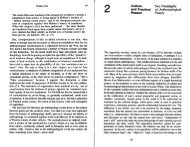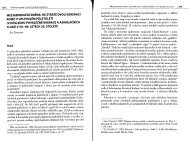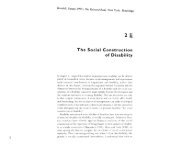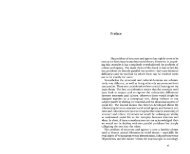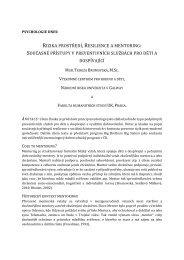Morphogenesis versus Structuration: On Combining ... - Moodle
Morphogenesis versus Structuration: On Combining ... - Moodle
Morphogenesis versus Structuration: On Combining ... - Moodle
Create successful ePaper yourself
Turn your PDF publications into a flip-book with our unique Google optimized e-Paper software.
<strong>Morphogenesis</strong> <strong>versus</strong> structuration 463<br />
centralization as reducible to the exercise of power by determinate<br />
actors.27 The voluntaristic bias means that institutions are what people<br />
produce, not what they confront-and have to grapple with in ways<br />
which are themselves conditioned by the structural features involved.28<br />
For Giddens institutional recursiveness never reflects the durability<br />
of constraint: it always represents the continuity of reproduction.<br />
Social System <strong>On</strong>ly at this level does Giddens concede that<br />
'unintended consequences of action stretch beyond the recursive<br />
effects of the duality of structure',29 producing what others would<br />
term 'emergent properties', but which he calls 'self-regulating properties'.<br />
Immediately and categorically he asserts that it is their facilitating<br />
effects upon which theory should centre-'the self-regulating properties<br />
of social systems must be grasped via a theory of system contradiction<br />
.30 The reason for this one-sidedness is that to Giddens<br />
contradictions represent cracks through which radical change can be<br />
forced by social conflict-'ceterzs paribus, conflict and contradiction<br />
have a tendency to coincide'.3l But is he warranted in concentrating<br />
on systemic contradiction alone and in ignoring systemic compatibilities<br />
altogether<br />
From the morphogenetic perspective contradictions, though very<br />
important, are only one of many deviation-amplifying mechanisms.<br />
To Maruyama the latter<br />
are ubiquitous: accumulation of capital in industry, evolution of<br />
living organisms, the rise of cultures of various types, interpersonal<br />
processes which produce mental illness, international conflicts,<br />
and the processes that are loosely termed as 'vicious circles' and<br />
'compound interests': in short, all processes of mutual causal<br />
relationships that amplify an insignificant or accidental initial<br />
kick, build up deviation and diverge from the initial condition.32<br />
Obviously sc me of the above examples involve conflict, but 'felicitous<br />
circles' and 'compound interests' do not, yet they contribute to<br />
structure-building. The close relationship between conflict and change<br />
belongs more to the history of sociology than to theories of selfregulation<br />
in complex systems.<br />
Giddens's studious neglect of compatibilities-those relations and<br />
exchanges among components which tend to preserve or maintain<br />
a system's given form, organization or state-derives partly from<br />
his valid rejection of functional equilibration but perhaps owes more<br />
to the fact that such morphostatic processes are experienced as constraints<br />
by others in social life. Nevertheless in complex socio-cultural<br />
systems, the positive and negative feedback loops producing morphogenesis<br />
and morphostasis respectively, also circulate simultaneously.<br />
This means that Giddens provides an inherently partial account of<br />
the systemic conditions of change and stability. His attempt to bow<br />
out of this by contesting that there is 'little point in looking for an



